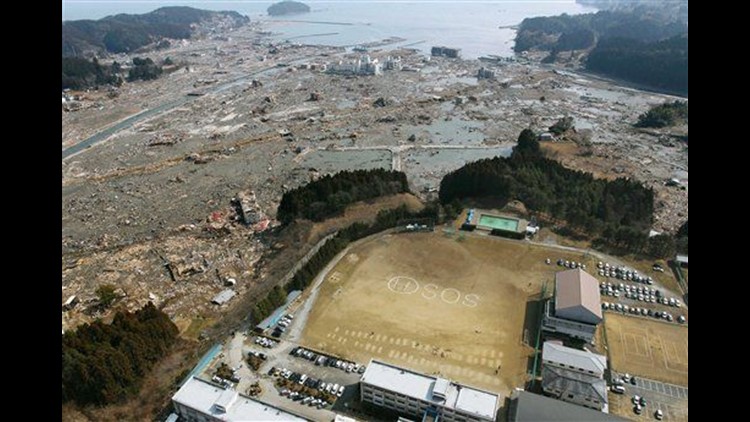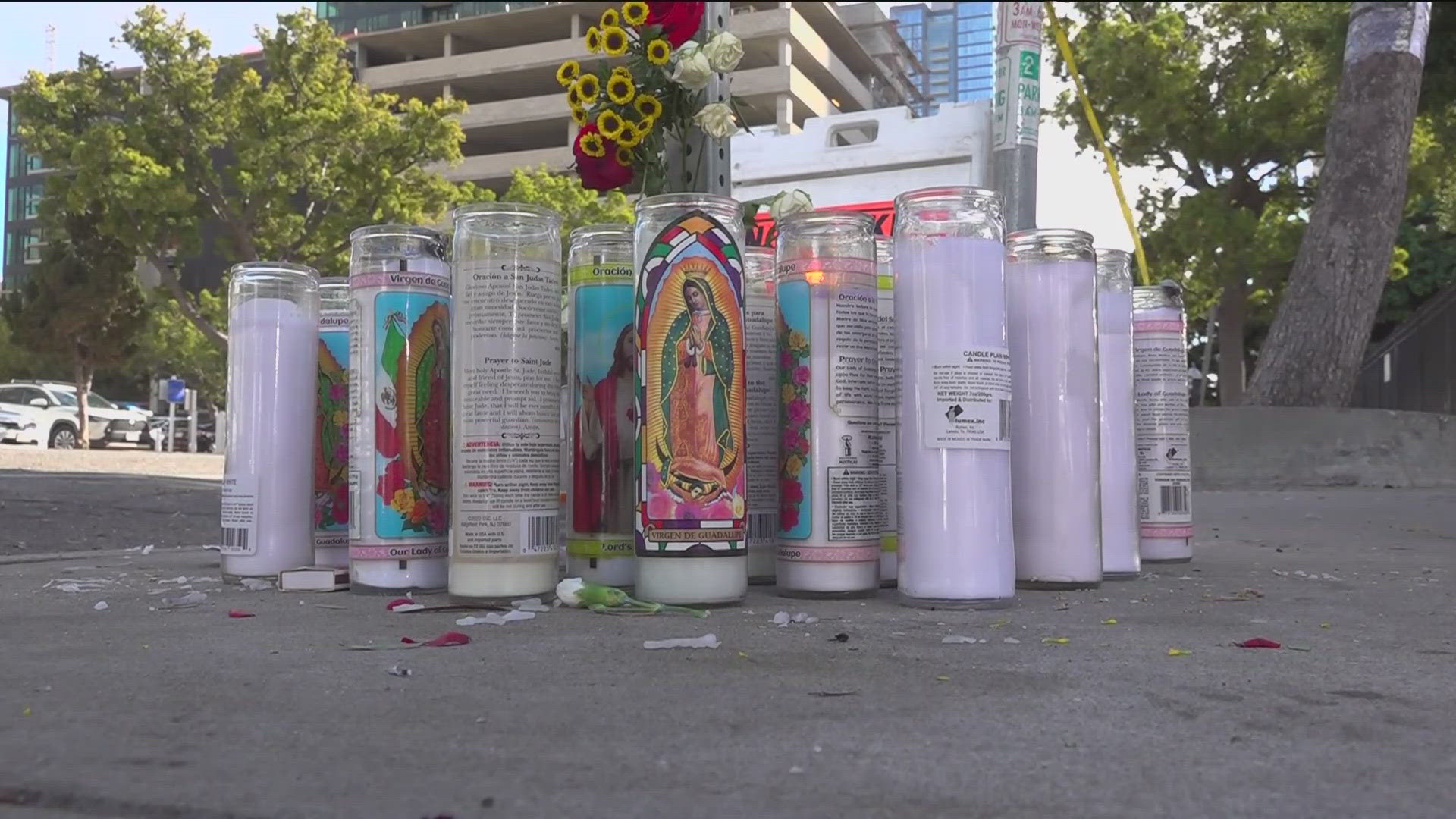TAGAJO, Japan (AP) — People across a devastated swath of Japan suffered for a third day Sunday without water, electricity and proper food, as the country grappled with the enormity of a massive earthquake and tsunami that left more than 10,000 people dead in one area alone.
Japan's prime minister called the crisis the most severe challenge the nation has faced since World War II, as the grim situation worsened. Friday's disasters damaged two nuclear reactors, potentially sending one through a partial meltdown and adding radiation contamination to the fears of an unsettled public.
Temperatures began sinking toward freezing, compounding the misery of survivors along hundreds of miles (kilometers) of the northeastern coast battered by the tsunami that smashed inland with breathtaking fury. Rescuers pulled bodies from mud-covered jumbles of wrecked houses, shattered tree trunks, twisted cars and tangled power lines while survivors examined the ruined remains.
In Rikusentakata, a port city of over 20,000 virtually wiped out by the tsunami, Etsuko Koyama escaped the water rushing through the third flood of her home but lost her grip on her daughter's hand and has not found her.
"I haven't given up hope yet," Koyama told public broadcaster NHK, wiping tears from her eyes. "I saved myself, but I couldn't save my daughter."
To the south, in Miyagi prefecture, or state, the police chief told a gathering of disaster relief officials that his estimate for deaths was more than 10,000, police spokesman Go Sugawara told The Associated Press. Miyagi has a population of 2.3 million and is one of the three prefectures hardest hit in Friday's disaster. Only 379 people have officially been confirmed as dead in Miyagi.
According to officials, at least 1,200 people were killed — including 200 people whose bodies were found Sunday along the coast — and 739 were missing in the disasters.
For Japan, one of the leading economies with ultramodern infrastructure, the disasters made ordinary life unimaginably difficult.
Hundreds of thousands of hungry survivors huddled in darkened emergency centers that were cut off from rescuers, aid and electricity. At least 1.4 million households had gone without water since the quake struck and some 1.9 million households were without electricity.
While the government doubled the number of soldiers deployed in the aid effort to 100,000 and sent 120,000 blankets, 120,000 bottles of water and 110,000 liters of gasoline plus food to the affected areas, Prime Minister Nato Kan said electricity would take days to restore. In the meantime, he said, electricity would be rationed with rolling blackouts to several cities, including Tokyo.
"This is Japan's most severe crisis since the war ended 65 years ago," Kan told reporters, adding that Japan's future would be decided by the response to this crisis.
In a rare piece of good news, the Defense Ministry said a military vessel on Sunday rescued a 60-year-old man floating off the coast of Fukushima on the roof of his house after being swept away in the tsunami. He was in good condition.
Large areas of the countryside remained surrounded by water and unreachable. Fuel stations were closed and people were running out of gasoline for their vehicles.
In the town of Minamisanrikucho, 10,000 people — nearly two-thirds of the population — have not been heard from since the tsunami wiped it out, a government spokesman said. NHK showed only a couple concrete structures still standing, and the bottom three floors of those buildings gutted. One of the few buildings standing was a hospital, and a worker told NHK hospital staff rescued about a third of the patients in the facility.
In Iwaki town, residents were leaving due to concerns over dwindling food and fuel supplies. The town had no electricity and all stores were closed. Local police took in about 90 people and gave them blankets and rice balls but there was no sign of government or military aid trucks.
At a large refinery on the outskirts of the hard-hit port city of Sendai, 100-foot (30-meter) -high bright orange flames rose in the air, spitting out dark plumes of smoke. The facility has been burning since Friday. The fire's road could be heard from afar, and a gaseous stench burned the eyes and throat.
"My water is cut off," said Kenji Fukuda, who lives in the rural town of Sukugawa. It "is a little bit rural and there is natural well water. We take it and put it through the water purifier and warm it up and use it in various ways," he said.
In the small town of Tagajo, near Sendai, dazed residents roamed streets cluttered with smashed cars, broken homes and twisted metal.
Residents said the water surged in and quickly rose higher than the first floor of buildings. At Sengen General Hospital the staff worked feverishly to haul bedridden patients up the stairs one at a time. With the halls now dark, those that can leave have gone to the local community center.
"There is still no water or power, and we've got some very sick people in here," said hospital official Ikuro Matsumoto.
One older neighborhood sits on low ground near a canal. The tsunami came in from the canal side and blasted through the frail wooden houses, coating the interiors with a thick layer of mud and spilling their contents out into the street on the other side.
"It's been two days, and all I've been given so far is a piece of bread and a rice ball," said Masashi Imai, 56.
Police cars drove slowly through the town and warned residents through loudspeakers to seek higher ground, but most simply stood by and watched them pass.
Dozens of countries have offered assistance. Two U.S. aircraft carrier groups were off Japan's coast and ready to provide assistance. Helicopters were flying from one of the carriers, the USS Ronald Reagan, delivering food and water in Miyagi.
Two other U.S. rescue teams of 72 personnel each and rescue dogs were scheduled to arrive later Sunday, as was a five-dog team from Singapore.
In Sendai, firefighters with wooden picks dug through a devastated neighborhood. One of them yelled: "A corpse." Inside a house, he had found the body of a gray-haired woman under a blanket.
A few minutes later, the firefighters spotted another — that of a man in black fleece jacket and pants, crumpled in a partial fetal position at the bottom of a wooden stairwell. From outside, the house seemed almost untouched, two cracks in the white walls the only signs of damage.
The man's neighbor, 24-year-old Ayumi Osuga, dug through the remains of her own house, her white mittens covered by dark mud.
Osuga said she had been playing origami, the Japanese art of folding paper into figures, with her three children when the quake stuck. She recalled her husband's shouted warning from outside: "'GET OUT OF THERE NOW!'"
She gathered her children — aged 2 to 6 — and fled in her car to higher ground with her husband. They spent the night huddled in a hilltop home belonging to her husband's family about 12 miles (20 kilometers) away.
"My family, my children. We are lucky to be alive," she said.
"I have come to realize what is important in life," Osuga said, nervously flicking ashes from a cigarette onto the rubble at her feet as a giant column of black smoke billowed in the distance.
___
Todd Pitman reported from Sendai. Associated Press writers Eric Talmadge and Kelly Olsen in Koriyama and Malcolm J. Foster, Mari Yamaguchi, Tomoko A. Hosaka and Shino Yuasa in Tokyo contributed to this report.
Copyright 2011 The Associated Press.



